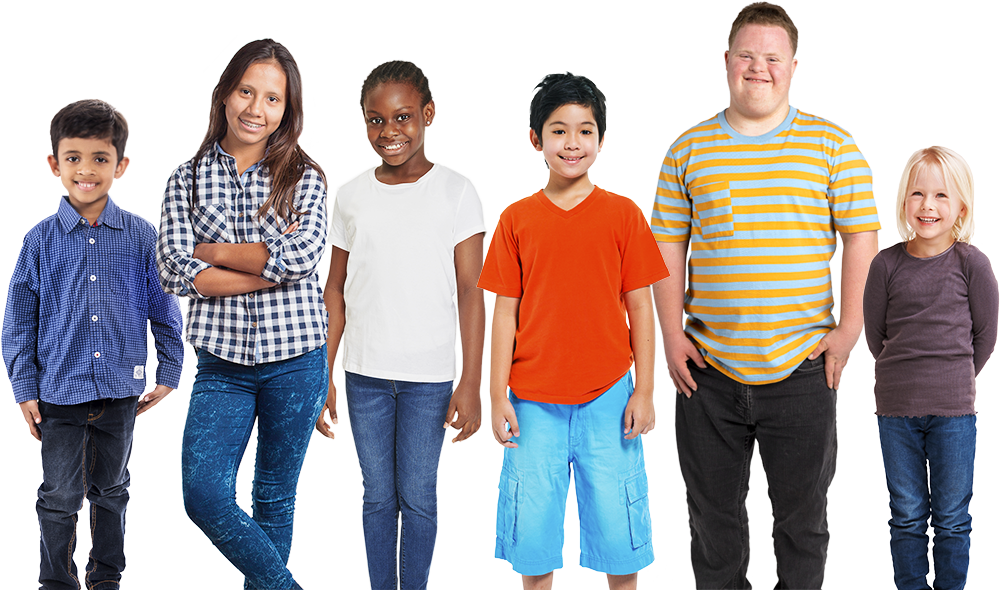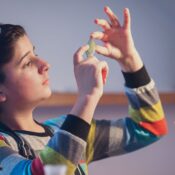Holistic Education: Transforming All School Spaces
A holistic approach to education isn’t new — in fact, its roots lie in ancient principles of instruction that focus on the entire educational experience. After falling out of favor, holistic development in education has gained traction again over the past 50 years and is a key focus for educators today even as resources shrink and educator responsibilities continue to grow. That focus naturally extends to learning spaces that foster holistic development in the spirit of inclusive education — spaces that offer holistic support as part of the mission to provide the best education possible for every student.
Let’s dig into the tenets of holistic education to better understand the need for, and benefit of, holistic learning spaces. As educational spaces move toward a more diverse, emotionally intelligent, dynamic student experience, we need to understand where holistic education is coming from and where it’s going.
What is Holistic Education?
Holistic education is an approach to learning that seeks to address the development of the whole person: intellectually, emotionally, socially, physically, artistically, creatively, and spiritually. It emphasizes interconnection and the need to foster a sense of balance, empathy, and well-being in students, alongside academic achievements. Holistic education focuses on developing well-rounded people instead of just coaching kids to clear the lowest bars of educational standards in order to move ahead. In fact, school mission and vision statements today typically focus on bringing the students’ whole selves to school, and supporting them accordingly.
Mainstream education takes a holistic slant in many ways. The key principles of holistic education include:
- Focus on the Whole Child:
- Holistic education nurtures not just intellectual development but also emotional intelligence, physical health, creativity, and moral and ethical values. Educators support these areas of development through counselor-led emotional support programs, health classes, art and music, and overarching school belief systems.
- Interconnected Learning:
- Subjects are integrated to reflect the real-world intertwinement, encouraging students to think critically and make connections between different areas of knowledge. Tying subjects and experiences together helps children to become well-rounded students and citizens who develop their own moral codes and learning styles.
- Student-Centered Approach:
- Learning is personalized, addressing the unique needs, interests, and potential of each student. This is an area where educators often struggle due to class sizes or lack of resources, but it’s arguably the most important for student development. It also requires participation and guidance from the students themselves, which means that students are likely to gravitate toward specific holistic spaces.
- Development of Lifelong Skills:
- Holistic education helps students develop skills such as communication, collaboration, problem-solving, and adaptability. We’re seeing more of a focus on applicable subjects in school, such as personal finance classes and creative extracurriculars. Educators can help students learn in and out of the classroom by enabling them to cultivate these skills and practice using them in holistic environments.
- Social and Emotional Learning:
- Social and Emotional Learning (SEL) builds emotional awareness, empathy, and interpersonal skills. SEL has come a long way in a short time, with school counselors today acting as a critical resource for students’ mental health as well as their academic success. Counselors are going far beyond what we’ve ever seen in this role, and fostering connections with students while helping to develop and understand emotional intelligence and understand each student’s unique needs.
- Experiential Learning:
- Prioritizes hands-on, real-world experiences, fostering deeper understanding and engagement. Holistic spaces are made for experiential learning, and this is a hot area for educator fundraising, as these spaces are tangible reminders of fundraising results. Concepts and designs for experiential learning spaces are endless, and with today’s focus on holistic education alongside strong fundraising capabilities, visions really can become reality.
- Community and Environment:
- Recognizes the importance of community involvement and environmental stewardship in education. Teaching students to not only give back but to take responsibility for the world we live in and those in it helps to develop children into community-minded adults. Educators are cultivating this citizenship-focused mindset from a young age, and Generation Alpha and beyond will take charge of their world and their futures using tools they learn in school.
- Focus on Inner Growth:
- Encourages mindfulness, self-reflection, and a sense of purpose. Quiet time can help students organize their minds, focus on reading, or spend time journaling and other types of personal storytelling. This focus is student-driven and can create a lifelong journey to personal growth and well being.
As you can see, holistic education is a well-developed ideology, but in today’s schools, it’s bursting out of the classroom and into tailor-made holistic learning spaces. There are critical benefits to harnessing the value of holistic instruction through these learning spaces that include band halls, athletic facilities, libraries, and open-concept collaboration areas.
Taking students out of the traditional four walls and putting them into customized holistic learning spaces helps them focus on the topic at hand, whether it’s sports, art, technology, or general studies.
Here’s a look at the benefits of holistic learning spaces for schools:
Fostering Holistic Development
- Physical Growth: Athletic facilities provide students with opportunities to enhance physical health, teamwork, discipline, and resilience. Physical activities have been linked to improved mental health and academic performance, and by allocating areas for physical growth and wellness, educators can ensure that students are building strong bodies to go with strong minds.
- Creative Expression: Band halls nurture creativity, cultural appreciation, and emotional intelligence through musical education. They also encourage collaboration, focus, and the ability to interpret and express complex emotions. Students of all ages may struggle to discuss feelings or find appropriate outlets for self-expression, but music is a universal language that is both an educational experience as well as a healthy outlet.
- Social Skills: Both spaces serve as platforms for students to develop interpersonal skills, including communication, leadership, and collaboration. These skills are critical for success in both personal and professional settings, and with productive and satisfying socialization as a lifelong need, these spaces contribute directly to building student futures.
Promoting Equity and Inclusion
- Catering to Diverse Interests: These spaces engage students who may not thrive in traditional academic settings, providing them with a sense of belonging and achievement. Inclusive schools recognize the varied talents and interests of students, ensuring every individual feels valued. Holistic spaces are safe places for students to show confidence in their skills and knowledge, make connections with educators and other students, and ultimately expand their learning ability.
- Accessibility: Inclusive schools ensure these facilities accommodate students of all abilities, fostering an environment where everyone can participate. For example, accessible sports programs and adaptive music technology make these spaces welcoming for students with disabilities. Accessibility means providing disabled students with the same opportunities and resources as typical students, and holistic learning spaces are great places to ensure equal opportunities.
- Cultural Representation: Band halls often introduce diverse musical traditions, promoting cultural understanding and respect among students from varied backgrounds. This doesn’t just promote inclusion from all students — it enables everyone to become well-rounded through exposure to new areas of culture, including art, language, cuisine, geography, history, and more. Inclusion comes with understanding, and with shared spaces that support cultural learning, U.S. schools are becoming true melting pots as intended.
Supporting Academic Achievement
- Studies show that physical activity and music education enhance cognitive functions, including memory, attention, and problem-solving. These benefits translate into better academic outcomes. Many schools have state-of-the-art athletic facilities, and when combined with music spaces and libraries, can enhance the individual experience of learning.
- Participation in extracurricular activities offered in these spaces is often linked to higher engagement and retention rates in schools. Engaged kids are happy kids, and many schools today are seeking ways to expand extracurricular spaces and offerings. From offering diverse languages to starting an intramural sports team, educators can find a variety of new ways to engage students and help them develop new skills, with the help of holistic learning spaces.
Aligning with Inclusive School Principles
- Whole-Child Approach: Inclusive schools aim to develop students academically, socially, emotionally, and physically. Facilities like these contribute to nurturing well-rounded individuals by addressing talents and interests beyond academics.
- Community Building: These spaces often bring together students, parents, and teachers, fostering a sense of community and shared purpose. They can also serve as a showroom for schools to highlight student projects, new technology and programs, and other accomplishments.
- Reducing Barriers: By investing in diverse facilities, inclusive schools reduce barriers to participation, allowing all students to access resources that support their growth. These spaces help to educate and grow students of all ages, races, genders, abilities, and talents.
Dedicated holistic spaces are more than just static areas — they are dynamic environments where students can explore their potential, build connections, and thrive. Holistic spaces bring inclusive education to life by celebrating diversity, promoting equity, and addressing the multifaceted needs of learners at every level. But these spaces often have to be built, and the resources aren’t always there to make it happen.
TeacherGiving enables educators and supporters to bring holistic learning spaces to life through community support. As a educator funding platform platform dedicated to education of all types, TeacherGiving provides teachers the tools to launch and manage fundraising campaigns. This allows schools and supporters to kick-start learning in holistic spaces and enhance the student experience in a multitude of ways.
Share:
Inspired by the TeacherGiving blog?
Discover resources, strategies, and stories that empower educators and transform classrooms. From fundraising tips to free downloadable tools, our blog is your go-to guide for innovative teaching and impactful learning. Subscribe today and never miss an update!
Recent Posts
12 States Lead Way in Providing Above Average Education
Navigating Digital Reading: Empowering Students in Internet-Based Learning
Unlock the Importance of Non-Classroom Learning Environments
End of the School Year Celebrations: Why They Matter

Be a Champion for Classrooms
Whether you’re an educator needing support or a supporter wanting to make a difference, TeacherGiving is here for you. Create an account or donate to help educators and enrich students’ learning experiences. Join us today and be a champion for classrooms!






